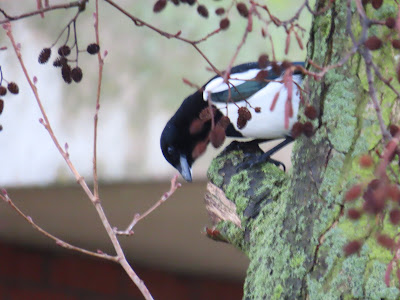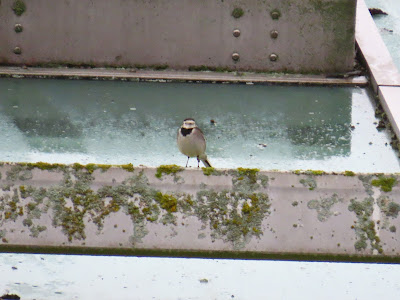
I'm fascinated by all corvids, but I love so many things about Jackdaws. The presence of a colony changes the soundscape of a street, with their constant, chattering 'kyak!' calls. They are also extremely social corvids, the members of a pair have life-long bonds, they are almost always together, often perching shoulder to shoulder. They also fly together, even when in a large flock and roost together, not far from their nest site, which they defend against other Jackdaws. Pairs join into larger social groups, or join other corvids like Rooks to feed in fields. They are at ease in crowds, being birds or other mammals. It's not unusual to see them perched atop resting cows in spring, pulling tufts of hair to line their nests. They feed around fresh dung, hunting flies, and pulverise older dung looking for dung beetles and larvae. In towns and cities, the most likely place to see Jackdaws is on chimney pots, their usual nest sites, although they will nest in other holes in buildings or mature trees if available.

One limitation to Jackdaw breeding is the blocking of old chimneys with pepper pots, and wire balloons. Here, one at the University of Hull with nesting material, on a blocked chimney pot. 6/04/2022.
Status and distribution in Hull
A few decades ago, it was hard to spot Jackdaws within the Hull boundary, in Birds of the Hull area they are noted as birds of the surrounding villages of Hull, with some apparent decline since the early 20th century in the inner city. Since then, UK populations have increased, and they appear to have colonised old haunts and new in Hull. Nowadays, although localised and in small numbers, they are more widespread, with colonies near Pearson Park and the avenues, at East Park and Orchard Park and near Ennerdale by the River Hull.
Pair of Jackdaws foraging at playing fields amongst loafind gulls. Sculcoates, 14/01/23.
A small flock of Jackdaws. University of Hull. 6/04/2022.
Pair of Jackdaws foraging amongst roosting gulls. Foster Street, 7/12/21.
Jackdaws are quite opportunistic, and will feed on acorns and chestnuts in the autumn. They consume food immediately, or carry it to feed on it somewhere else, but don't cache their food like Rooks and Jays.
Squabbles for nest sites are a common occurrence in early spring. 3/03/2015, Cranbrook Avenue.
Conservation and managementJackdaws are increasing in numbers in the UK and are green listed. They don't require special conservation measures, however, house renovations and chimney blocking, as felling of old trees with decaying holes will reduce the availability of nest sites and might limit spread.
More informationHeywood, J.J.N., Massimino, D., Balmer, D.E., Kelly, L., Marion, S., Noble, D.G., Pearce-Higgins, J.W., White, D.M., Woodcock, P., Wotton, S. Gillings, S. (2024) The Breeding Bird Survey 2023. BTO Research Report 765. British Trust for Ornithology, Thetford.





























































